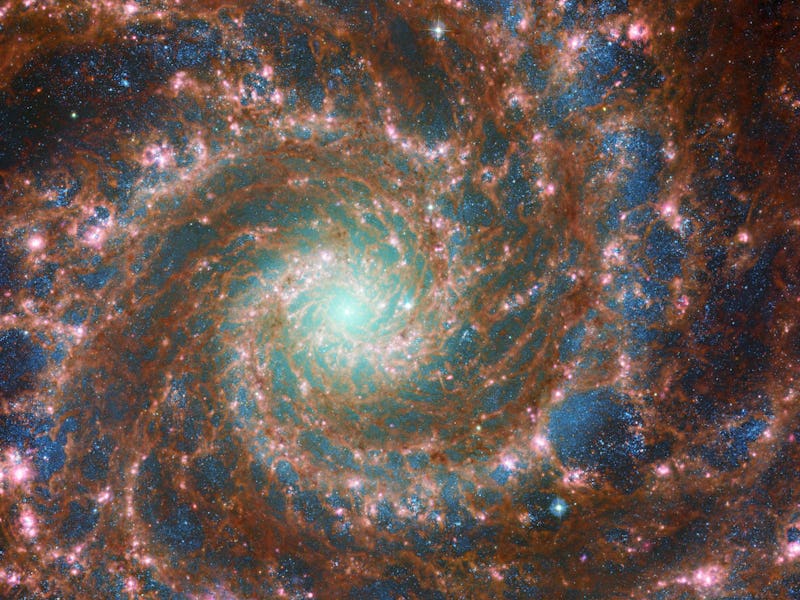Look! New Webb Telescope photos show eerily intricate details of the Phantom Galaxy
It’s official spooky season in space.

The James Webb Space Telescope’s Mid-InfraRed Instrument, MIRI, zoomed in a spiral galaxy 32 million light years away to help a team of astronomers study the earliest stages of star formation, and the result is a surreal, gorgeous image of M74, also called the Phantom Galaxy. But these stunning images, and the data behind them, wouldn’t tell astronomers half as much without help from the Hubble Space Telescope.
M74, the Phantom Galaxy, is the Platonic ideal of a spiral galaxy. It’s what astronomers call a “grand design spiral” because its arms are so clear and well-defined — “unlike the patchy and ragged structure seen in some spiral galaxies,” writes the European Space Agency in a recent statement. (While not naming names, ESA is clearly throwing some shade at the likes of spiral galaxy NGC 4237, which is 60 million light years away and doing its best.)
But don’t judge the Phantom Galaxy solely on its striking appearance; it’s also an interesting and eventful cosmic spot. Astronomers have witnessed three supernovae in M74 just in the past 20 years, and one of those was probably a hypernova, an extremely powerful type of supernova that happens when a star more than 30 times the mass of our Sun collapses to form a black hole. M74 might also be the home of an extremely rare intermediate-mass black hole, detected in 2005.
This image was produced by combining optical and ultraviolet data from Hubble with infrared data from Webb, assigning specific visible colors to the wavelengths of light that our eyes can’t actually see.
This image — focusing on the center of the Phantom Galaxy and the spiral arms of stars and dust radiating out from it — combines a false-color image from MIRI with an earlier image from Hubble, so we’re seeing features of the galaxy that normally aren’t visible in the same wavelengths of light. Notice the filaments of matter that seem to form lattices of gas and dust through the spiral arms; they’re much more visible in infrared than in optical or ultraviolet light.
MIRI is also imaging 18 other galaxies for the project, called PHANGS. To better understand how dense regions of dust and gas coalesce into burning stars, astronomers need to know details like ages, masses, and spectra (wavelengths of light, which can reveal the chemical makeup of an object) about star clusters, star-forming regions called nebulae, and loose dust floating in the interstellar medium. The new data from Webb will help fill in those blanks — but Webb can only see the universe in infrared, so astronomers need other telescopes to fill in other parts of the story.
The image on the left shows the features detected by Hubble; the image on the right shows the features detected by Webb; the center image combines the two.
All 19 galaxies chosen for PHANGS have previously been studied by Hubble and by ground-based telescopes. That allows astronomers to combine information from different wavelengths of light to learn more about star formation in these galaxies. In the Phantom Galaxy, for instance, Hubble already spotted several stellar nurseries blazing brightly with visible and ultraviolet light. Webb’s infrared view adds filaments of gas and dust weaving through the galaxy’s spiral arms, as well as a bright star cluster at the center of galaxy. Radio telescopes like the Atacama Large Millimeter Array (ALMA, in Chile) will yet reveal a different set of features.
“By combining data from telescopes operating across the electromagnetic spectrum, scientists can gain greater insight into astronomical objects than by using a single observatory — even one as powerful as Webb,” explains the European Space Agency.
This article was originally published on